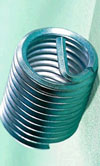Thread Inserts
 In previous articles on the subject of fasteners, we have dwelt very little on the subject of female threads, other than in the article talking of bespoke nuts. The other main situation where we will find female threads is where these have been machined into castings or into machined parts. Unless the rules forbid their use, it is likely that we will have chosen an aluminium block, or where we are designing bespoke parts, aluminium is a very popular material, either in its cast or wrought forms, owing to its low density. Where we look for low density, we may also choose to use magnesium or, perhaps, one of the higher strength polymers which are gaining in popularity.
In previous articles on the subject of fasteners, we have dwelt very little on the subject of female threads, other than in the article talking of bespoke nuts. The other main situation where we will find female threads is where these have been machined into castings or into machined parts. Unless the rules forbid their use, it is likely that we will have chosen an aluminium block, or where we are designing bespoke parts, aluminium is a very popular material, either in its cast or wrought forms, owing to its low density. Where we look for low density, we may also choose to use magnesium or, perhaps, one of the higher strength polymers which are gaining in popularity.
Each of the low density materials has, in general, an Achilles' heel where female threads are concerned and that is the low strength of the material, especially where repeated disassembly is a factor. Small diameter threads are often a problem in these materials and sometimes, after little use, the threads can be in a state of distress. Sometimes the favoured repair is to move, where possible to a larger thread, but in a lot of cases, we will reach for the thread repair kit, often referred to as the 'helicoil' kit.
Helicoil is a trade name and is often used to collectively describe any wound wire thread inserts, although they may not actually be 'helicoils'. Fitting a helicoil is a multi-stage process requiring special tooling and some care. Initially we must remove the damaged thread, and this is done by the simple process of drilling. We then take a special tap, which is of a larger size than the thread to be repaired, but of the same pitch. After tapping the hole to the correct depth, the wound wire insert is fitted using a special tool, normally supplied by the manufacturer of the insert. Generally, the inserts are wound into place using a 'tang' on the end of the insert, and this must be broken off before the insert is used with a bolt / screw.
Wire inserts are generally available in lengths which are multiples of the nominal screw diameter, and also in a range of materials; stainless steel is the default material, but others are available including bronze and titanium. A range of surface finishes are also available including silver plating.
There are different types of wire inserts and some incorporate a self-locking feature which acts much as a prevailing-torque nut does. One coil is deliberately deformed to provide an increased torque on the fastener. In areas where a loose screw may be a risk, as mentioned in the previous article on locking nuts, these screw-locking inserts are often used to good effect.
Whilst many consider wound wire inserts to be a repair scheme only, it is common to find them specified in new components, either to increase longevity or to increase the strength of the thread, allowing a shallower thread to withstand the design pre-load without damage to the female thread. We shall look at other forms of thread inserts in a future article.
One point to bear in mind with wire inserts, or any kind of ferrous insert in aluminium parts, is that they must be installed after anodising, if this process is specified. It leads to severe damage of both the insert and the aluminium part during the anodising process.
Fig. 1 - Wound wire insert showing drive tang.
Written by Wayne Ward